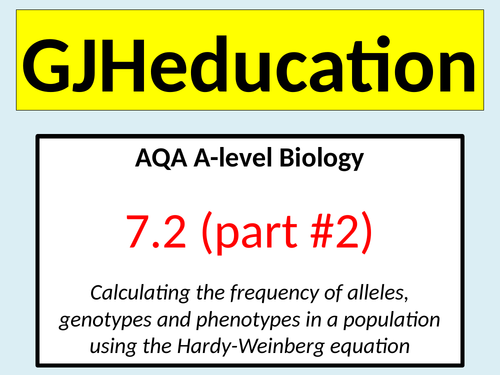




This fully-resourced lesson guides students through the use of the Hardy-Weinberg equation to calculate the frequency of alleles, genotypes and phenotypes in a population. Both the detailed PowerPoint and differentiated practice questions on a worksheet have been designed to cover the 2nd part of point 7.2 of the AQA A-level Biology specification which expects students to be able to use this mathematical model
The lesson begins by looking at the equation and ensuring that students understand the meaning of each of the terms. The recessive condition, cystic fibrosis, is used as an example so that students can start to apply their knowledge and assess whether they understand which genotypes go with which term. Moving forwards, a step-by-step guide is used to show students how to answer a question. Tips are given during the guide so that common misconceptions and mistakes are addressed immediately. The rest of the lesson gives students the opportunity to apply their knowledge to a set of 3 questions, which have been differentiated so that all abilities are able to access the work and be challenged.
Get this resource as part of a bundle and save up to 38%
A bundle is a package of resources grouped together to teach a particular topic, or a series of lessons, in one place.
AQA A-level Biology Topic 7: Genetics, populations, evolution and ecosystems
This bundle contains 15 fully-resourced and detailed lessons that have been designed to cover the content of topic 7 of the AQA A-level Biology specification which concerns genetics, populations, evolution and ecosystems. The wide range of activities included in each lesson will engage the students whilst the detailed content is covered and the understanding and previous knowledge checks allow them to assess their progress on the current topic as well as challenging them to make links to other related topics. Most of the tasks are differentiated to allow differing abilities to access the work and be challenged. The following sub-topics are covered in this bundle of lessons: * The use of genetic terminology * The inheritance of one or two genes in monohybrid and dihybrid crosses * Codominant and multiple alleles * The inheritance of sex-linked characteristics * Autosomal linkage * Epistasis as a gene interaction * The use of the chi-squared test * Calculating allele frequencies using the Hardy-Weinberg principle * Causes of phenotypic variation * Stabilising, directional and disruptive selection * Genetic drift * Allopatric and sympatric speciation * Species, populations, communities and ecosystems * Factors affecting the populations in ecosystems * Estimating the size of a population using randomly placed quadrats, transects and the mark-release-recapture method * Conservation of habitats frequently involves the management of succession This is one of the 8 topics which have to be covered over the length of the 2 year course and therefore it is expected that the teaching time for this bundle will be in excess of 2 months If you want to see the quality of the lessons before purchasing then the lessons on codominant and multiple alleles, epistasis and phenotypic variation are free resources to download
Maths in A-level Biology (AQA A-level Biology)
"Overall, at least 10% of the marks in assessments for biology will require the use of mathematical skills" This sentence is taken directly from the AQA A-level Biology specification and clearly shows that being able to apply these skills in the context of biology will have a significant impact on a student's chances of success. This bundle has been created to cover as much of those mathematical skills as possible and the following specification points are covered by these 6 lessons: * Represent phenotypic ratios (monohybird and dihybrid crosses) * Use and manipulate the magnification formula * Use the chi-squared test to test the significance of the difference between observed and expected results * Use the Hardy-Weinberg principle to calculate changes in allele frequency * Calculate an index of diversity for a habitat A revision lesson is also included in this bundle which acts as a fun and engaging revision of the range of calculations
Something went wrong, please try again later.
This resource hasn't been reviewed yet
To ensure quality for our reviews, only customers who have purchased this resource can review it
Report this resourceto let us know if it violates our terms and conditions.
Our customer service team will review your report and will be in touch.